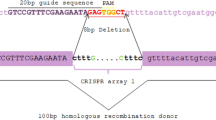Summary
Integrative transformation of yeast with gapped DNA fragments results in single or multiple integration into the yeast genome via homologous recombination. A sequence of yeast DNA was found which favours multiple integration even when the strategy of gene replacement is used. This strategy by which the transformed DNA fragment replaces its chromosomal homologue rather than simply integrating into the genome usually occurs as a single exchange event. The described region is unique and lies ear a telomere about 5 kb proximal to the SUC4 locus on chromosome XIII. DNA from this region was used as a vehicle for the integration of different SUC genes coding for invertase. Most of the sucrose fermenting transformants isolated carried between two and seven copies of the SUC genes. These transformants overproduced invertase even though there was no selective pressure for high invertase activity in these experiments. I conclude that this region is highly recombinogenic and favours multiple integration of DNA fragments. This region could be used for stable multiple integration of heterologous genes into the yeast genome for over-production of the respective gene product.
Similar content being viewed by others
References
Beggs JD (1978) Nature 275:447–452
Beggs JD (1981) Alfred Benzon Symp 16:383–390
Bennetzen JL, Hall BD (1982) J Biol Chem 257:3018–3025
Birnboim HC (1983) Methods Enzymol 100:243–255
Bitter GA, Chen KK, Banks AR, Lai DH (1984) Proc Natl Acad Sci USA 81:5330–5334
Blackburn EH, Szostak JW (1984) Ann Rev Biochem 53:163–194
Bolivar F, Backman K (1979) Methods Enzymol 68:245–267
Botstein D, Falco SC, Stewart SE, Brennan M, Scherer S, Stichcomb DT, Struhl K, Davis RW (1979) Gene 8:17–24
Bull JH, Wootton JC (1984) Nature 310:701–704
Carlson M, Botstein D (1982) Cell 28:145–154
Carlson M, Botstein D (1983) Mol Cell Biol 3:351–359
Carlson M, Celenza J, Eng FJ (1985) Mol Cell Biol 5:2894–2902
Chan CSM, Tye BK (1983) Cell 33:563–573
Chen CY, Hitzeman RA (1987) Nucleic Acids Res 15:643–660
Fogel S, Welch JW (1982) Genetics 79:5342–5346
Futcher AB, Cox BS (1984) J Bacteriol 157:283–290
Goldstein A, Lampen JO (1975) Methods Enzymol 42: 504–511
Grossmann MK, Zimmermann FK (1979) Mol Gen Genet 175: 223–229
Hinnen A, Meyhack B (1982) Curr Top Microbiol Immunol 96: 101–117
Hinnen A, Hicks JB, Fink GR (1978) Proc Natl Acad Sci USA 75:1929–1933
Hitzeman RA, Clarke L, Carbon J (1980) J Biol Chem 255: 12073–12080
Hitzeman RA, Leung DW, Perry JL, Kohr WJ, Levine HL, Goeddel DV (1983a) Science 219:620–625
Hitzeman RA, Chen CY, Hagie FE, Patzer EJ, Liu CC, Estell DE, Miller JV, Yaffe A, Kleid DG, Levinson AD, Oppermann H (1983b) Nucleic Acids Res 11:2745–2762
Hohmann S, Zimmermann FK (1986) Curr Genet 11:217–225
Hohman S, Zimmermann FK (1986) Curr Genet 11: 217–225
Kelly JM, Hynes MJ (1987) Curr Genet 12:21–31
Messing J (1983) Methods Enzymol 101:20–77
Murray AW, Szostak JW (1983) Nature 305:189–193
Orr-Weaver TL, Szostak JW (1983) Mol Cell Biol 3:747–749
Orr-Weaver TL, Szostak JW, Rothstein RJ (1981) Proc Natl Acad Sci USA 78:6354–6358
Parent SA, Fenimore CM, Bostian KA (1985) Yeast 1:83–138
Rigby PW, Dieckman M, Rhodes C, Berg P (1977) J Mol Biol 113:237–251
Rothstein RJ (1983) Methods Enzymol 101:202–211
Sharp PM, Tuohy TMF, Mosurski KR (1986) Nucleic Acids Res 14:5125–5143
Smith RA, Duncan MJ, Moir DT (1985) Science 229:1219–1224
Stewart GG (ed) (1987) Biological research on industrial yeast, vol 2, fundamental aspects. CRC Press
Stinchcomb DT, Thomas M, Kelly J, Selker E, Davis RW (1979) Proc Natl Acad Sci USA 77:4559–4563
Tautz D, Renz M (1983) Anal Biochem 132:14–19
Thim L, Hansen MT, Norris K, Hoegh J, Boel E, Forstrom J, Ammerer G, Fiil NP (1986) Proc Natl Acad Sci USA 83: 6766–6770
Valenzuela P, Medina A, Rutter WJ, Ammerer G, Hall BD (1982) Nature 298:347–350
Wahl GM, Stern M, Stark GR (1979) Proc Natl Acad Sci USA 76:3683–3687
Wernars K, Goosen T, Wennekes LMJ, Visser J, Bos CJ, van den Broek HWJ, van Gorcom RFM, van den Hondel CAMJJ, Pouwels PH (1985) Curr Genet 9:361–368
Zamenhoff S (1957) Methods Enzymol 3:696–704
Zhu J, Contreras R, Fiers W (1986) Gene 50:225–237
Author information
Authors and Affiliations
Rights and permissions
About this article
Cite this article
Hohmann, S. A region in the yeast genome which favours multiple integration of DNA via homologous recombination. Curr Genet 12, 519–526 (1987). https://doi.org/10.1007/BF00419561
Received:
Issue Date:
DOI: https://doi.org/10.1007/BF00419561




